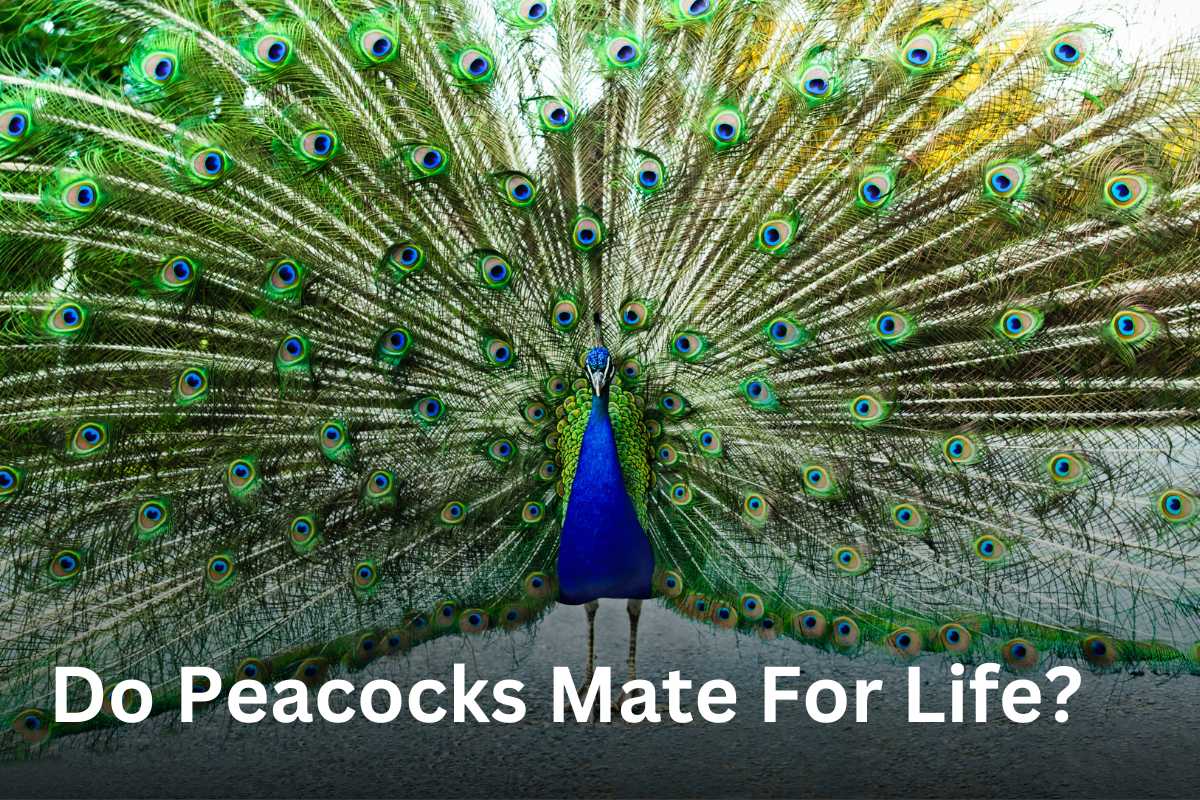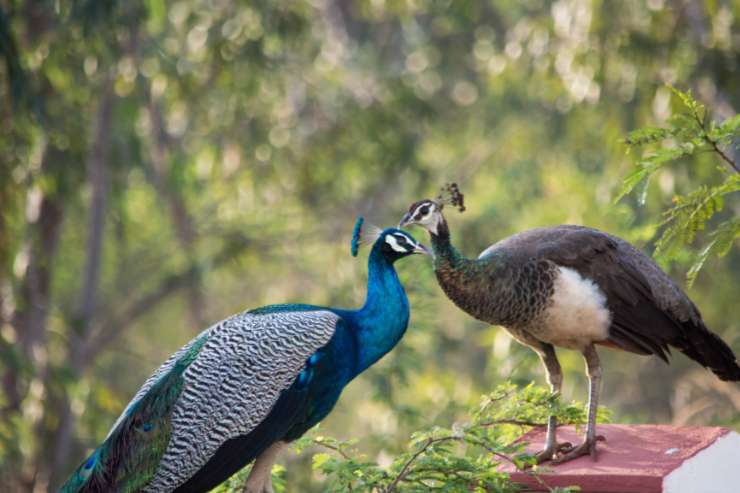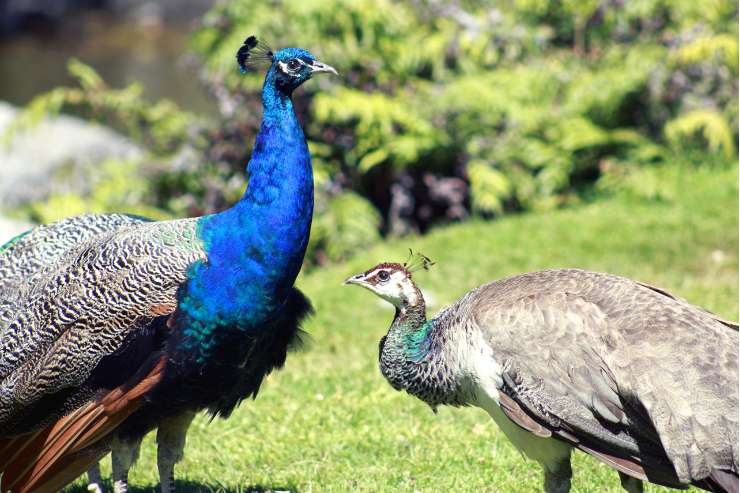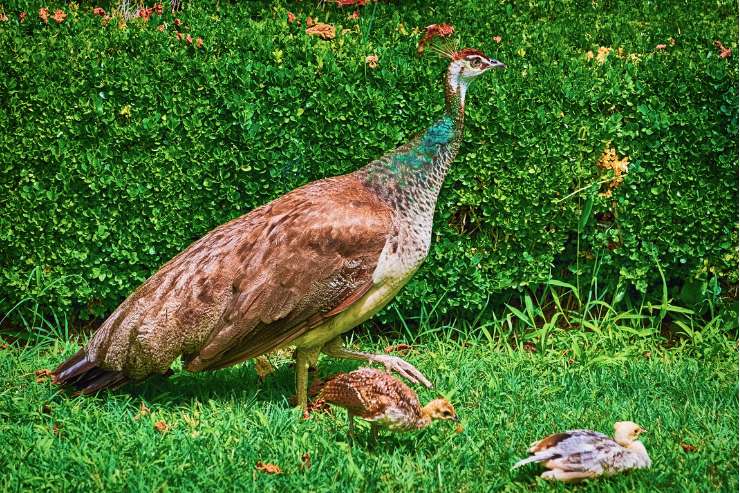Do Peacocks Mate for Life?

Peacocks are birds with gorgeous feathers and a majestic behavior who have long been praised for their captivating look.
From the stunning colors of their dazzling feathers to the complex display of their enormous tails, these birds represent beauty and grace in the avian universe. Amidst the appeal of their stunning beauty, one question arises: do peacocks mate for life?

This question delves into the complexities of peacock behavior and social dynamics, prompting an investigation into the captivating birds’ breeding practices and relationships.
So, let’s see if peacocks develop lifetime relationships or if nature’s rhythms influence their interactions.
Understanding Peacock Behavior:
A. Description of peacock social behavior:
Peacocks exhibit complex social behaviors within their communities. They often form loose associations known as flocks, which consist of several peafowl, including both males (peacocks) and females (peahens), along with their offspring.
Within these flocks, a dominance hierarchy often exists, with dominant males building their power through actions and vocalizations.
Peahens, on the other hand, play an essential part in mate selection and have been shown to prefer certain males depending on a variety of factors, such as the quality of their displays and the healthiness of their feathers.
B. Mating rituals and displays:
Mating rituals among peacocks are intricate and visually impressive displays designed to attract peahens.
The renowned “train display,” in which a peacock fanned out his iridescent tail feathers to create a stunning variety of colours and patterns, is central to these rituals.
Vocalizations and movements accompany this show, which is intended to attract the attention of the surrounding peahens.
C. Factors influencing peacock mating behavior:
Several factors influence peacock mating behavior, including social dynamics, environmental conditions, and individual characteristics.
Dominant males often enjoy greater mating success due to their ability to monopolize resources and intimidate rival suitors.
Environmental factors such as habitat quality and food availability can also impact mating behavior, with peafowl being more likely to engage in courtship displays and mate selection in areas rich in resources.
Additionally, individual characteristics such as age, health, and genetic fitness play a role in determining a peacock’s attractiveness as a mate.
Peahens are known to prefer males with vibrant plumage, which indicates good health and genetic quality. They also consider factors such as display performance and territorial dominance.
Monogamy vs. Polygamy in Peafowl:
A. Explanation of monogamy and polygamy in the animal kingdom:
Monogamy and polygamy are two distinct mating strategies recognized throughout the animal kingdom.
Monogamy is the formation of limited pair bonds between one male and one female, which frequently leads to shared responsibilities in parenting and obtaining resources.
In contrast, polygamy refers to mating systems with several mates, either concurrently (polygyny) or sequentially (polyandry).
Polygyny is common in animals where males compete for females, resulting in a skewed gender ratio and high degrees of sexual variation.
B. Research on peacock mating habits:
Research on peacock mating habits has revealed a complex interplay between monogamous and polygamous tendencies within the species.
Peafowl are commonly described as polygynous, with dominant males mating with numerous females in their territory.
Observations suggest that while dominant males may engage in polygamous behavior, subordinate males and less competitive males may form monogamous pairs with specific females.
C. Insights into peacock pair bonding:
Peacock pair ties are frequently formed by mutual mate selection, with both males and females showing preferences for specific mates based on criteria such as displaying excellence, health, and compatibility.
Once developed, pair relationships can last for a long time, with males and females working together to nest, raise, and defend their territory.
However, the long-lasting nature of pair bonds can be modified by a variety of circumstances, such as changes in social dynamics and environmental conditions, demonstrating the adaptability of peacock mating techniques within complex social networks.
Peacock Mating Season:
A. Timing and duration of peacock mating season:
Peacock mating season usually begins in early spring and lasts until early summer. Male peacock train feathers start to come in, indicating that mating season is coming.
The timing of the mating season may differ slightly depending on geographical location and local weather conditions.
In areas with milder winters, mating activity can begin as early as late winter, whereas in colder places, it may be postponed until warmer temperatures arrive.
The mating season lasts several weeks or months, during which peafowl participate in wooing shows, mate selection, and reproductive activity.
B. Importance of mating rituals during this period:
During the peacock mating season, mating rituals are essential because they serve as elaborate displays to attract possible mates and establish reproductive success.
The renowned train display, which features the male’s brilliant tail feathers spread out in a magnificent array, is crucial to these rituals.

Males use these displays to promote their genetic fitness, health, and dominance to prospective mates while also discouraging competitor suitors.
The intensity and frequency of mating rituals rise during mating season, with males dedicating significant time and energy to sexual displays in order to increase their chances of mating.
C. Impact of environmental factors on mating behavior:
Environmental factors have a considerable impact on peacock mating behavior during the mating season.
Favorable ecological circumstances, such as plentiful food resources, excellent nesting places, and ideal weather, are critical for increasing mating activity and reproductive success.
Adequate food availability keeps peafowl in peak physical condition for breeding, while good nesting locations offer shelter and safety to nesting pairs and their offspring.
Furthermore, environmental cues such as day length and temperature fluctuations may cause hormonal changes in peafowl, signaling the start of the breeding season and synchronizing reproductive activities among populations.
Adverse environmental conditions, such as drought, habitat degradation, or extreme weather events, can disrupt mating patterns in peafowl populations, resulting in lower reproductive success and population reduction.
Factors Influencing Mate Selection:
A. Role of physical attributes in mate selection:
Peafowl mate selection is greatly influenced by physical characteristics such as brilliant plumage and complex train displays.
During courtship rituals, females are drawn to these male traits because they are not only visually appealing but also serve as markers of genetic fitness and health.
The size, symmetry, and shimmering effect of a male’s tail feathers influence a female’s mate selection, demonstrating the evolutionary importance of these characteristics.
Peahens frequently favor males with more extensive and brighter plumage, as these characteristics indicate vitality and reproductive capacity.
Similarly, males may consider females’ physical traits, such as body size and feather quality, when choosing mates, although their preferences may be less evident than those of females.
B. Behavioral cues and compatibility:
Mate selection in peafowls takes into consideration both physical characteristics and behavioral clues.
Males demonstrate their prowess with elaborate feathers and vocalizations, whereas females evaluate their performance.
Peafowls prefer harmonious relationships, so temperament, communication, and societal dynamics all impact mate selection.
Pair bonding involves cooperative collaboration in activities such as nesting and territorial defence, emphasizing the importance of behavioural compatibility.
C. Influence of competition and social hierarchy:
Both competition and social hierarchy influence peafowl mate selection. Dominant males, with their territorial dominance and availability of resources, frequently have high mating success and are preferred by females in the breeding season.
Male-male competition for mates can include aggressive displays, vocalizations, and physical confrontations in which dominant males demonstrate their control over rivals.
In other circumstances, subordinate males may use different mating techniques, such as creating monogamous pair bonds with specific females or engaging in sneak copulations to avoid dominant males’ territorial defences.
The social hierarchy of peafowl flocks influences mate selection by determining peafowl access to partners, resources, and reproductive possibilities, showing the complex interplay between competition, dominance, and mate choice in peacock mating dynamics.
Lifespan of Peacock Relationships:
A. Duration of peacock pair bonding:
The duration of peacock pair bonding varies considerably based on social dynamics, environmental conditions, and individual traits.
While some peafowl may create very short-term pair relationships that last only one breeding season, others may sustain long-term partnerships that last several years.
The durability of pair bonding is frequently determined by the quality of the relationship between peafowls, with aspects such as mutual compatibility, cooperation, and shared responsibilities all playing a role.

In rare circumstances, pair connections can last beyond the breeding season, with mated pairs continuing to interact with one another outside of reproductive activities.
B. Instances of long-term monogamy in peafowl:
While peafowl are commonly described as polygynous, with dominant males mating with numerous females, long-term monogamy has been observed in the species.
Remarkably submissive or less competitive peacocks may create exclusive pair bonds with specific females, resulting in long-term monogamous relationships.
These monogamous peafowls may engage in activities such as mutual grooming, cooperative nesting, and territorial defence, indicating a deep attachment between them.
Genetic studies have also found indications of gene monogamy in peafowl populations, implying that some pairings may be faithful to each other for long periods of time.
C. Factors leading to the dissolution of pair bonds:
Although peafowl have the capacity for long-term pair bonding, a variety of events can cause pair connections to dissolve.
Changes in social dynamics, such as the introduction of new peahens or shifts in the dominance hierarchy, can disrupt existing pair connections, resulting in the separation of mating pairs.
Environmental variables such as habitat loss, food scarcity, and natural disasters can potentially disrupt pair bonds by raising stress levels and lowering reproductive success rates.
Furthermore, factors such as health concerns, age-related deterioration, or reproductive failure may contribute to the collapse of pair bonds.
Infidelity or mate desertion can occur when one partner fails to meet their duties or when more enticing mating chances become available, putting peacock partnerships under more strain.
Overall, the longevity of peacock partnerships is determined by a complex interplay of elements, emphasizing the species’ mating dynamics.
Conclusion
Peacocks are not known for mating for life. They are polygamous birds, meaning they mate with multiple partners during the breeding season.
Male peacocks, known for their vibrant plumage and elaborate courtship displays, typically mate with several females in their territory. After the breeding season, they may seek new mates in the following seasons.
So, while they don’t mate for life, they do engage in seasonal mating behaviors. However, while peacocks are not typically monogamous for life, there are instances of long-term pair bonds forming between mates.
These bonds can be influenced by factors such as mutual compatibility and environmental conditions.
Thus, while peacocks primarily exhibit seasonal mating behaviors, they can also develop long-lasting relationships under certain circumstances.
Frequently Asked Question
How do peacocks attract mates?
Peacocks attract mates primarily through elaborate courtship displays. These displays involve fanning out their varicolored tail feathers in a striking array of colors and patterns, accompanied by vocalizations and movements designed to capture the attention of nearby peahens.
What role do peahens play in mate selection?
Peahens play a vital role in mate selection by assessing the quality of male displays and choosing mates based on traits such as the vibrancy of their plumage, health, and genetic fitness. Peahens may also exhibit preferences for males with dominant social status and access to resources.
Do peacocks compete for mates?
Yes, peacocks often engage in competitive behaviors to secure mating opportunities. Male-male competition may involve aggressive displays, vocalizations, and physical confrontations, with dominant males typically enjoying greater mating success and access to females.
